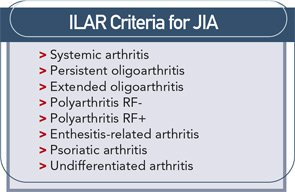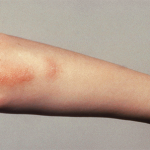MTX rapidly enters cells, where it is polyglutamated by hepatocytes, red cells, fibroblasts, bone-marrow myeloid precursors, and possibly other cells. Polyglutamated methotrexate accumulates intracellularly and may explain the emergence of nausea and vomiting in patients after several years of treatment. The hope was that levels of intracellular polyglutamated MTX will correlate with response to MTX, but that has not been the case to date.
MTX is well tolerated by children and does not appear to be more toxic than NSAIDs, if monitored properly. Common side effects in children include elevation of serum aminotransferase levels and nausea. Transient mucositis can occur, while hematologic abnormalities are uncommon, and there are reports of headache, alopecia, gastric ulcer, and mood changes. There are multiple strategies for decreasing side effects, the most important being recognition of the potential role of NSAIDs. Many side effects from NSAIDs are similar to those of MTX. Withholding a dose of NSAID before and/or after MTX administration, changing the NSAID, or discontinuing it may improve MTX tolerance. When faced with GI symptoms in an individual, try giving MTX at bedtime, changing MTX to subcutaneous, or administering an antiemetic before MTX administration. If these strategies fail, the dose of MTX may need to be lowered.
Because folic acid depletion is thought to contribute to MTX side effects, most clinicians prescribe a daily vitamin with folate or folate 1 mg/day.
Other side effects to consider are:
- Pneumonitis is rarely reported in children treated with MTX for rheumatic diseases;
- Cirrhosis has not been reported in children using MTX for rheumatic diseases;
- Oncogenic potential is low. There are only rare reports of lymphoma in patients with JIA. Reports in adults with RA may be Epstein-Barr virus–related or related to the background risk from persistently active disease;
- Gonadal function and reproduction are not altered by MTX. However, both males and females should wait for three months after discontinuing MTX before trying to conceive because MTX is a powerful teratogen. Young women receiving MTX should repeatedly be reminded to use effective birth control.
Leflunomide
After absorption, leflunomide is metabolized into an active metabolite which reaches peak levels between six and 12 hours. The most common adverse reactions are gastrointestinal symptoms: diarrhea, anorexia, abdominal pain, dyspepsia, gastritis, and elevation of transaminases. Other problems occurring in approximately 5% to 10% of patients include rash/allergic reactions, headache, and reversible alopecia. Less common are weight loss and hypophosphatemia. Neither the prodrug nor the active metabolite are dialyzable. Elimination can be hastened by the use of cholestyramine. Leflunomide is teratogenic. There are no long-term studies to assess its carcinogenicity or effect on fertility.
Cyclosporine
This is uniquely effective for treating macrophage activation syndrome (MAS) (see p.27 for more on MAS). Use 3 to 5 mg/kg intravenously, and change to oral dosing when disease is controlled.
Biologic Therapies
Etanercept, infliximab, adalimumab, anakinra, abatacept, and rituximab have all been demonstrated or reported to be effective in treating JIA. Their use in children poses special problems, including the increased risk of infections (especially varicella); uncertainty about the timing and performance of the usual immunizations; concerns about the potential long-term effects of biologic medications on younger children with developing immune systems; and the possibilities of later malignancies or possible development of central nervous system demyelinating disease.

